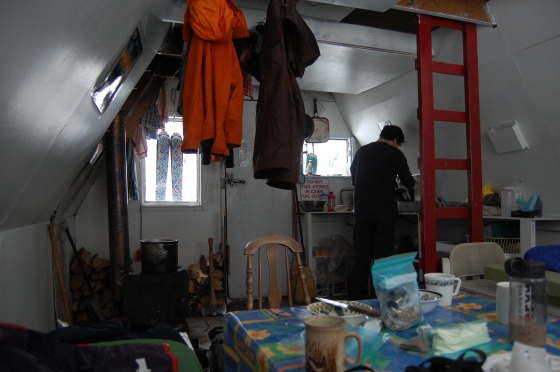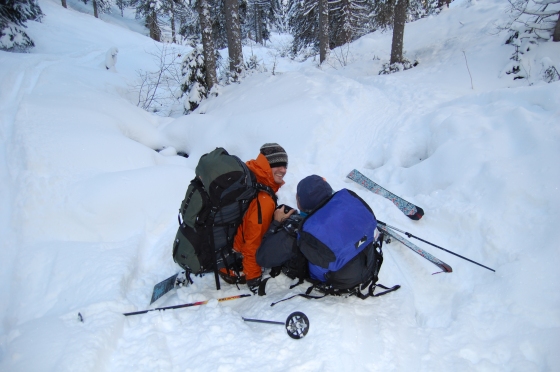These days, as a student, I don’t get to go adventuring much. But this summer came an opportunity I couldn’t pass up.
My boyfriend Eric’s longtime friend Martina was getting married in their hometown of Quesnel, BC. Since we’d be in the North, Eric suggested we hike the Berg Lake Trail, in the Mount Robson Provincial Park, after the wedding. And so, I took a week off work and spent four days in the Alpine Rockies.
Driving East from Prince George, BC along Highway 16, you pass through the foothills and eventually the Rocky Mountains. One of the most photographed mountains in the Canadian Rockies is Mount Robson, whose summit is only visible 28 days out of the year. Luckily, the sun and the summit were out all four days of our expedition.
Day 1: Mount Robson Campground to Whitehorn
The hike begins from the parking lot at the base of Mount Robson, at an elevation of 853m. You immediately cross the Robson River and begin following it. In fact, the Berg Lake Trail follows the Robson River all the way to the Robson Glacier, some 30k+ up the trail. But I’ll get there in a bit.

Mount Robson from the Base Parking Lot
On day one, the hike was a relatively stead and flat 10k. We stopped not far after the 4k point on a beach on Kinney Lake, through which the Robson River passes, for lunch. We couldn’t help but feel lucky for the weather, especially considering it was pouring hard the night before.
The trail hugs along the shoreline of Kinney Lake for another two kilometers to the Kinney Lake campground. We crossed a few streams and even passed through a small island mid-river.

Eric taking a breather by Kinney Lake
The 6k to 7k stretch led us up and down along the River through a forest we dubbed “the Lord of the Rings Forest”. The trail wound around massive boulders that appear to have fallen off of the cliffs above. These massive rocks are almost perfectly cubed in shape, as if they were giant toy blocks for a giant baby to play with.
The last few kilometers to Whitehorn Campground were again not too difficult. They rose gently through the shaded forest, with framed views of Kinney Lake and the valley below and behind us.
We finally arrived at the campground, still with much daylight left. We set-up our tent and made dinner: spiced couscous with dried fruits, beef jerky and pepperoni.
Distance traveled on Day 1 = 11k. Elevation gain = 244m.
Day 2: Whitehorn campground to Berg Lake Campground
We started early one Day Two. I have a habit of getting up early and I can’t seem to shake it, even on vacation. Whitehorn campground is nestled neatly in the Valley of a Thousand Falls. Walking through the valley, it’s easy to see why it holds this name. Everywhere, on every mountain ledge above, you can see a tiny waterfall trickling down the mountain side.
After an easy stride across the valley, the trail meets another steep hill and goes up and up and up.
The trial snakes along a steep hill, passing three waterfalls along the way: the White Falls, the Falls of the Pools, and finally the breathtaking Emperor Falls.
We had only gone up a few hundred meters up the path before I needed to stop for “fuel”. A few hundred meters later, we stopped again for lunch in a shady patch on a cliff overlooking Emperor Falls.
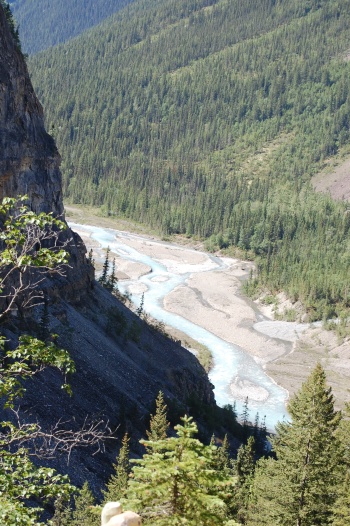
Elevation gain from Whitehorn to Emperor Falls
After reaching the top of the hill, we still had another 6k ahead of us and the terrain wasn’t exactly peachy. Immediately after Emperor Falls comes the Emperor Falls campground. After a few hundred meters of gentle forest path, still following Robson River, the path curves around steep slopes of sheath. Looking down ahead, we could see Mist Lake.

Me, with the Mist Glacier in the background.
The trail hugs around the steep hills until it finally descends into a plain. Thanks to the ice ages that have passed before us, the plain is barren and uninhabitable except for a few tiny shrubs every hundred meters or so. It stretches out for a half-kilometer wide and over a kilometer in length. At the edge of the plain, you have a wonderful view of Mist Lake.
The trial swoops back into the forest for the final three kilometers along Berg Lake to Berg Lake campground. Cue jaw drop.
The Berg Lake campground is tucked away in an evergreen forest along the Southwest side of Berg Lake facing the majestic Berg Glacier, a five-thousand year-old block of ice cemented into Mount Robson. Every ten minutes or so, you can hear a cracking in the distance. That’s the sound of ice breaking off the Glacier and splashing into the Lake below, forming icebergs which float to shore.
We didn’t bother setting up our tent right away. The sun was still strong in the early afternoon so we decided to take a dip in the lake. Key word: dip. Not swim. We lay on the pebbled beach, basking in the sun for an hour or so.
We had climbed over 800m that day and had another 800m ahead of us the next.
For dinner, we had Kraft Dinner and a dehydrated meal. Kraft Dinner for the win.
After dinner, we went on a nice stroll along the Lake and sat on a log bench watching the Glacier.

Mount Robson at dusk.
Distance traveled on Day 2 = 10k. Elevation gain = 544m.
Day 3: Day hike to Snowbird Pass
Unlike many of the other hikers who attempted Snowbird Pass that day, we slept in. We had been warned the night before by other campers that Snowbird Pass is easily an eight-hour trek, so best you get up early. We had planned to get up at 7 and hit the trails by 9. Instead, we awoke at 9:12AM and we were ready to go just after 11. I wasn’t too thrilled at the prospect that we’d stuck in the mountains until 7PM. That didn’t faze Eric, though.
The hike is 22k to the Pass and back, and can be divided into four sections. The first section, the flattest, is three kilometers of sheath rock trail along the Robson River. It winds along the West bank of the Robson River around the West side of Rearguard Mountain. This is when you get your first glimpse of the Robson Glacier at the mouth of the Robson River.
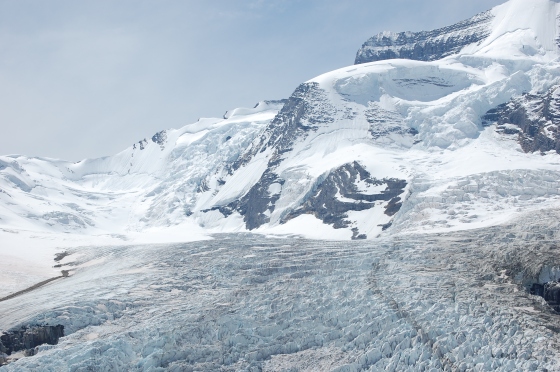
Robson Glacier
During this first section of the hike, we passed many hikers going back to camp. They had started early, but nearing noon when they had reached the halfway point, the weather began to look less promising, with grey clouds quickly approaching. Attempting the second part in clear skies is treacherous alright. Forget about doing it in the rain. Because of this, many of the early bird hikers had turned back before reaching the Pass. Once we reached the beginning of the second section, at the foothill of a steep ascent, the clouds began to clear.
The second section begins abruptly with a sharp turn up towards the mountains, climbing over boulders. It’s hard to follow as the trail isn’t well walked on, but marked by cairns every couple of meters or so. We stopped twice at two glacier-fed streams for water. We had already depleted our 2.5 L we had brought with us from camp and we were not even at the halfway point yet.
At the top, the trail turns into a narrow rock walkway, only a meter wide, that drops off into the valley below, some 800m down. This walkway offers the best view of the Robson Glacier, to the East. On the ascent, I found this walkway spectacular. On the descent, I found it terrifying as you can see very well how far down your body will fall if you take a wrong step. By the way, there is nothing to hold on to. A heavy Easterly gust could push you over the edge.
At the end of the rock walkway, about a kilometer long, the trail curves up around a waterfall and then dips into a meadow. The third section, Alpine Meadow, is quite the surprise. After spending the last three hours on dry rocks, with little to no vegetation, you’re suddenly immersed in this Sound of Music meadow with a stream running through it and butterflies dancing in the air.
We sat in the Meadow to eat our lunch. We soon realized some marmots closeby were planning a covert operation to steal our lunch.
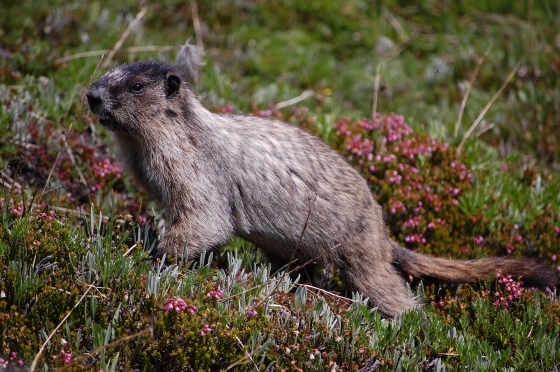
Marmot!
During lunch, another hiker passed by on his way back to camp. He told us we weren’t far from the Pass, only 2k.
After our short break, we began making our way to the Pass. From the Meadow, the Pass is less than a 2k distance but at an elevation gain of 100m from the Meadow. It’s steep. And past a certain point, you realize you’re feeling the effect of high altitude as climbing gets harder and harder. Each step takes more energy than the last and you’re moving slower than your Great Aunt Martha.
Eventually, though, we made it to the top of Snowbird Pass, a saddle wedged between Lynx Mountain and Titkana Mountain looking East over the Coalman Icefield. This makes it all worth it. The ice field is huge. Imagine looking down at Greater Vancouver from Grouse and seeing a giant sheet of ice. Here, we are at an elevation of 2,428m.

Atop Snowbird Pass, overlooking the Coalman Icefield
We didn’t stay for long. Again, we had run out of water and were starting to get hungry. The descent back down to camp took three hours, but we booked it near the end, almost sprinting. Needless to say, we were exhausted!
That night, we had curried eggplant and rice burritos for dinner. Amazing!
Total distance traveled on Day 3= 22k. Elevation gain = 800m.
Day 4: Berg Lake to Mount Robson parking lot. Then drive to Jasper
For the second time this week, and a rare event in itself, Eric got up first. And boy was it early. 4:54 AM, to be exact. We ate a big breakfast; trying to finish off any food we had leftover. We left the camp just past 7AM and only stopped at Whitehorn for second breakfast, then shortly after so I could change into shorts and t-shirt.
After Emperor Falls, we began passing lots of day hikers.
Eventually, we had to stop again. Eric’s legs were soar and my feet were aching. We stopped at Kinney Lake for some water and to soak our feet in the cold lake to ease the soreness. We were only 5k from the parking lot. So close!
But we made it. Getting to the car was such a relief. We were so tired and sore, but so happy. We did it!
Total distance traveled on Day 4: 21k. Elevation gain = – 1,600m.
Total distance traveled since Day 1: 63k.
Overall, the Berg Lake Trail is an excellent way to spend a few days in the Rockies. Reservations are required, meaning the trail doesn’t get too crowded in the summer. Day hikes to Kinney Lake and Emperor Falls are free, but I recommend going farther. The further the better. There are plenty of day hikes to do from the Berg Lake Campground, so you can spend more than a few nights there.
Until next time,
🙂 Julie

